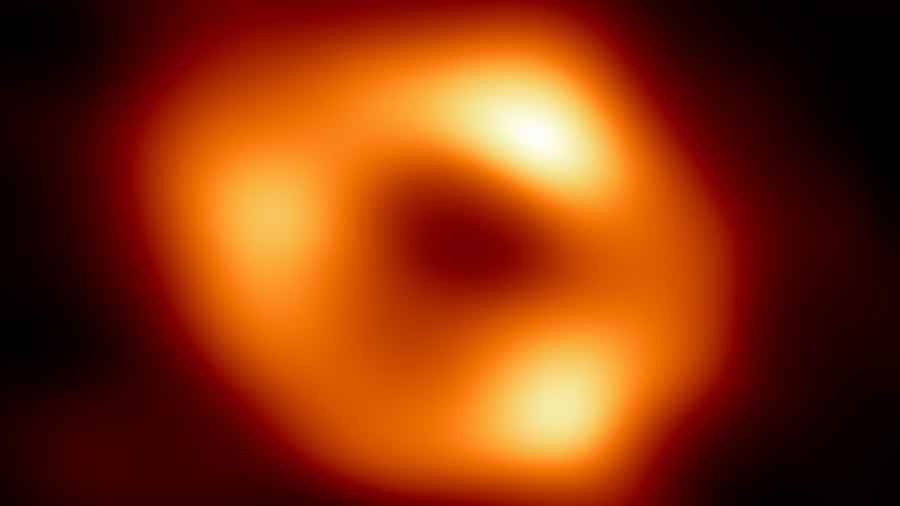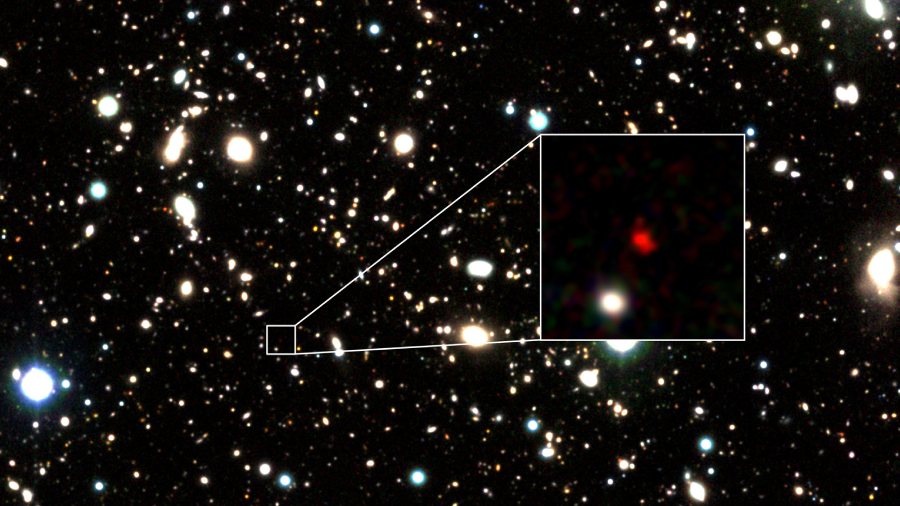Astronomers announced on Thursday that they had pierced the veil of darkness and dust at the centre of our Milky Way galaxy to capture the first picture of “the gentle giant” dwelling there: a supermassive black hole, a trapdoor in space-time through which the equivalent of 4 million suns have been dispatched to eternity, leaving behind only their gravity and a violently bent space-time.
The image, released in six simultaneous news conferences in Washington, DC, and around the globe, showed a lumpy doughnut of radio emission framing an empty space as dark and silent as death itself.
The new image joins the first ever picture of a black hole, produced in 2019 by the same team, which photographed the monster at the heart of the M87. The image shows new details of the astrophysical violence and gravitational weirdness holding sway at the centre of our placid-looking hive of starlight.
Black holes were an unwelcome consequence of Albert Einstein’s general theory of relativity, which attributes gravity to the warping of space and time by matter and energy, much as a mattress sags under a sleeper.
Einstein’s insight led to a new conception of the cosmos, in which space-time could quiver, bend, rip, expand, swirl and even disappear forever into the maw of a black hole, an entity with gravity so strong that not even light could escape it.
Einstein disapproved of this idea, but the universe is now known to be speckled with black holes. Many are the remains of dead stars that collapsed inward on themselves and just kept going.
But there seems to be a black hole at the centre of nearly every galaxy, ours included, that can be millions or billions of times as massive than our sun. Astronomers still do not understand how these supermassive black holes have grown so big.
Paradoxically, despite their ability to swallow light, black holes are the most luminous objects in the universe. Materials — gas, dust, shredded stars — that fall into a black hole are heated to millions of degrees in a dense maelstrom of electromagnetic fields. Most of that matter falls into the black hole, but some is squirted out by enormous pressures and magnetic fields.
Such fireworks, which can outshine galaxies by a thousand-fold, can be seen across the universe; when first observed in the early 1960s, they were called quasars. Their discovery led physicists and astronomers to take seriously the notion that black holes existed.
What gave rise to such behemoths of nothingness is a mystery. Dense wrinkles in the primordial energies of the Big Bang? Monster runaway stars that collapsed and consumed their surroundings in the dawning years of the universe?
The centre of the Milky Way coincides with a faint source of radio noise called Sagittarius A*. Astronomers including Andrea Ghez of the University of California, Los Angeles, and Reinhard Genzel of the Max Planck Institute for Extraterrestrial Physics calculated that whatever was there has the mass of 4.14 million suns.
They gained that estimate by tracking the orbits of stars and gas clouds swirling about the centre of the Milky Way and measuring their velocities at one-third the speed of light. For their achievement, Genzel and Ghez won the Nobel Prize in physics in 2020.
According to research that goes back to a 1967 paper by the physicist James Bardeen, the Sagittarius black hole, if it is there, should appear as a ghostly dark circle amid a haze of radio waves. At 50 million miles across, this hollow shadow would appear about as big from Earth as an orange on the moon.
Astronomers have been trying to sharpen the acuity of their telescopes to resolve the shadow of that orange. But ionised electrons and protons in interstellar space scatter the radio waves into a blur that obscures details of the source. “It’s like looking through shower glass,” Sheperd Doeleman, an astronomer at the Harvard-Smithsonian Center for Astrophysics, said recently.
To see deeper into the black hole shadow, researchers needed to be able to tune their radio telescopes to shorter wavelengths that could penetrate the haze. And they needed a bigger telescope.
In 2009, Doeleman and his colleagues formed the Event Horizon Telescope, an international collaboration that now comprises more than 300 astronomers from 13 institutions. Today, it employs 11 different radio telescopes around the world, which act in concert to form a telescope as big as the globe, as Doeleman likes to say.
The telescope is named after the point of no return around a black hole. The team scored its first triumph in April 2019, when it presented a picture of the M87 black hole. In 2021, team members refined their data to reveal magnetic fields swirling around the black hole like a finely grooved rifle barrel pumping matter and energy into the void.
Sagittarius A*, the black hole in the Milky Way galaxy, is a harder target. It is less than one-thousandth the mass and size of the M87 hole and, therefore, evolves a thousand times faster. The M87 black hole barely budges during a weeklong observing run, but Sagittarius A* changes its appearance as often as every five minutes.
The challenge for black-hole cinema will be to separate what changes from what stays the same — to delineate the underlying structure of the black hole from the matter that is moving around in it.
The results could be spectacular and informative, said Janna Levin, a gravitational theorist at Barnard College of Columbia University, who was not part of the project. “I’m not bored with pictures of black holes yet,” she said.
New York Times News Service











